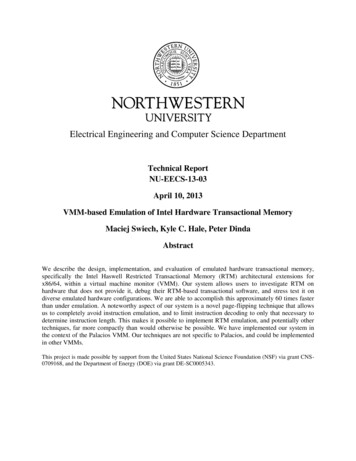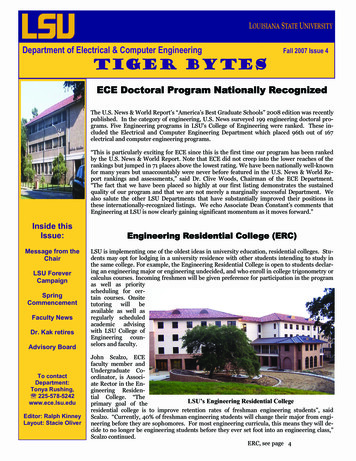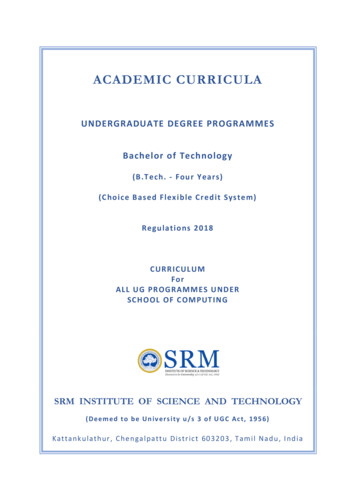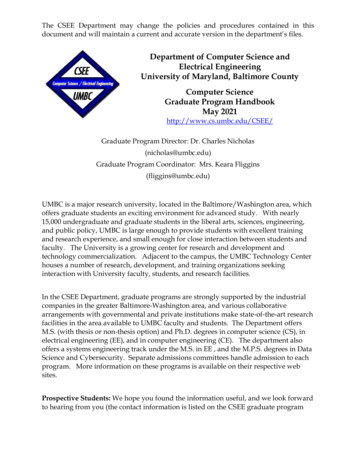
Transcription
Electrical Engineering and Computer Science DepartmentTechnical ReportNU-EECS-13-03April 10, 2013VMM-based Emulation of Intel Hardware Transactional MemoryMaciej Swiech, Kyle C. Hale, Peter DindaAbstractWe describe the design, implementation, and evaluation of emulated hardware transactional memory,specifically the Intel Haswell Restricted Transactional Memory (RTM) architectural extensions forx86/64, within a virtual machine monitor (VMM). Our system allows users to investigate RTM onhardware that does not provide it, debug their RTM-based transactional software, and stress test it ondiverse emulated hardware configurations. We are able to accomplish this approximately 60 times fasterthan under emulation. A noteworthy aspect of our system is a novel page-flipping technique that allowsus to completely avoid instruction emulation, and to limit instruction decoding to only that necessary todetermine instruction length. This makes it possible to implement RTM emulation, and potentially othertechniques, far more compactly than would otherwise be possible. We have implemented our system inthe context of the Palacios VMM. Our techniques are not specific to Palacios, and could be implementedin other VMMs.This project is made possible by support from the United States National Science Foundation (NSF) via grant CNS0709168, and the Department of Energy (DOE) via grant DE-SC0005343.
Keywords: virtual machine monitors, hypervisors, operating systems, hardware transactionalmemory
VMM-based Emulation of Intel Hardware Transactional MemoryMaciej SwiechKyle C. HalePeter DindaDepartment of Electrical Engineering and Computer ScienceNorthwestern uAbstractserver is of overarching importance, not just in systemssoftware, but also in libraries and applications.HTM promises better correctness in concurrent codeby replacing locking with transactions over instructions.Unlike locks, such transactions are composable, meaningthat it is less likely to introduce deadlock and livelockbugs as a codebase expands. Furthermore, transactionshave the potential for running faster than locks becausethe hardware is able to detect violations of transactionindependence alongside of maintaining coherence.Intel has made HTM a component of its next generation x86/64 platform, Haswell, and the first chips areexpected to ship in late 2013. This paper focuses onthe restricted transactional memory (RTM) componentof Intel’s specification. RTM is a bit of a misnomer—it might better be called explicit transactional memory.With RTM, the programmer starts, aborts, and completestransactions using new instructions added to the ISA.Our work does not address the other component of Intel’s specification, hardware lock elision (HLE), whichis a mechanism for promoting some forms of existinglock-based code to transactions automatically—i.e., it isimplicit transactional memory.Our paper focuses on how to extend a virtual machinemonitor (VMM) so that it can provide the guest with Intel Haswell RTM capability even if the underlying hardware does not support it. A natural question is why thisemulation capability would be useful. There are threeimmediate use cases. The first is straightforward: withour capability, it is possible to investigate RTM withouthaving any hardware that actually supports it. Our workmakes it possible to build and test guest kernel and application functionality that leverages RTM on any hardwarethat can run the VMM.The second use case is in testing RTM code againstdifferent hardware models, to attempt to make the codeWe describe the design, implementation, and evaluation of emulated hardware transactional memory, specifically the Intel Haswell Restricted Transactional Memory (RTM) architectural extensions for x86/64, withina virtual machine monitor (VMM). Our system allowsusers to investigate RTM on hardware that does not provide it, debug their RTM-based transactional software,and stress test it on diverse emulated hardware configurations. We are able to accomplish this approximately 60times faster than under emulation. A noteworthy aspectof our system is a novel page-flipping technique that allows us to completely avoid instruction emulation, and tolimit instruction decoding to only that necessary to determine instruction length. This makes it possible to implement RTM emulation, and potentially other techniques,far more compactly than would otherwise be possible.We have implemented our system in the context of thePalacios VMM.Our techniques are not specific to Palacios, and could be implemented in other VMMs.1IntroductionHardware transactional memory (HTM) [6] is a longstanding concept that holds considerable promise for improving the correctness and performance of concurrentprograms on hardware multiprocessors. Today’s typical server platforms are already small scale NUMA machines with O(64) hardware threads spread over O(4)sockets constituting a midrange server. Further, it iswidely accepted that the growth path of single node performance depends on increased concurrency within thenode. For example, the U.S. national exascale effortsare crystallizing around a model of billion-way parallelism [1], of which a factor of 1000 or more is anticipated to be within a single node [15]. Given these trends,correct and efficient concurrency within a single node or1
resilient to different and changing hardware. As we describe in more detail in Section 2, transaction aborts arecaused not only by the detection of failures of transaction independence, but also by other events that arestrongly dependent on specific hardware configurations.For example, the RTM specification notes that a cachemiss may cause a transaction abort. Hence, a transactionthat may succeed on one processor model might aborton another model. Our emulated RTM functionality allows hooking in model-specific properties, allowing for awider range of testing and future-proofing of RTM code.The third use case is in debugging RTM-using codevia a controlled environment. Through emulation, it ispossible to introduce abort-generating events at specificpoints and observe the effects. It is also possible to collect detailed trace data from running code.We have designed, implemented, and evaluated a system for Intel RTM emulation within the Palacios VMM.Our techniques are not specific to Palacios, and could beimplemented in other VMMs as well. Our contributionsare as follows:bounded transactional memory [2] shows that hardwaredesigns that allow arbitrarily long transactions are feasible, and this work also demonstrated that using suchtransactions would allow for significant speedups in Javaand Linux kernel code. Hammond et al [5] have arguedfor using such powerful transactions as the basic unit ofparallelism, coherence, and consistency. In contrast tosuch work, our goal is simply to efficiently emulate aspecific commercially available HTM system that willhave model-specific hardware resource limitations. Byusing our system, programmers will be able to test howdifferent hardware limits might affect their programs.However, because the conditions under which our system aborts a transaction are software defined, and thecore conflict detection process will work for a transaction of any size, provided sufficient memory is available,our system could also be employed to test models suchas the ones described above.Our system leverages common software transactionaldata structures, such as hashes and redo logs. Moore etal developed an undo log-based hardware transactionalmemory system [13] which lets all writes go through tomemory and rolls them back upon conflict detection. Ouremulator rolls a redo log forward on a commit. We have designed a page-flipping technique thatallows instruction execution while capturinginstruction fetches, and data reads and writes. Thistechnique avoids the need for any instructionemulation or complex instruction decoding—theonly decoding functionality we need is todetermine the instruction length. Given thebaroque nature of the x86/64 ISA, this greatlysimplifies RTM emulation and could be applied toother services. We have designed an emulation technique for RTMbased around the page-flipping technique,redo-logging, undefined opcode exceptions, andhypercalls. The technique is extensible, allowingfor the inclusion of different hardware models, forexample different cache sizes and structures. We have implemented the RTM emulation techniquein Palacios. The entire technique comprises about1300 lines of C code. We have evaluated our VMM-based RTM emulationtechnique and compared it with Intel’semulator-based implementation of Haswell RTMin the Software Development Emulator [8]. Ourimplementation is approximately 60 times fasterwhen a transaction is executing, and has fullperformance when none are.2Transactional memory on Intel HaswellWithin the Haswell generation of processors, Intel willimplement hardware transactional memory. The specification for transactional synchronization extensions(TSX) [7] has the goals of providing support for newcode that explicitly uses transactions, backward compatibility of some such new code to older processors, and allowing for hardware differences and innovation under theISA-visible model. There are two models supported byTSX, hardware lock elision (HLE) and restricted transactional memory (RTM). Our focus in this paper is onRTM, although we comment in the conclusion about howour emulation could be extended to HLE.In the RTM model, four additional instructions havebeen added to the ISA: XBEGIN, XEND, XABORT, andXTEST. The code first uses CPUID checks to determineif these instructions are available on the specific hardware. If they are executed on hardware which does notsupport them, a #UD (undefined opcode) exception isgenerated. Code can use the XTEST instruction to determine if it is executing within a transaction. An RTMtransaction is typically written in a form similar to thefollowing:Related work: Herlihy and Moss introduced HTM [6].Recent work by Rajwar, Herlihy, and Lai showed howHTM could be extended such that hardware resourcelimitations would not be programmer visible [14]. Un-start label:XBEGIN abort label body of transaction 2
Instructions within the virtualization extensions SMX instructions A range of privileged instructions such as HLT,MONITOR/MWAIT, RD/WRMSR, etc.An important point is that our system does not require decoding and emulating general instructions, and to aborton one of these classes of instructions we need onlydecode an instruction sufficiently to identify its class.Any such decoding need happen only for the instructionswithin the transaction. Furthermore, many of these instructions are already detected in the VMM out of necessity (e.g., control and segment register updates, I/Oinstructions, virtualization instructions, most privilegedinstructions), and others can be readily intercepted without decoding (e.g. RFLAGS updates, debug registers,ring transitions, TLB instructions, software interrupts).Exceptions: An exception on the core executing a transaction generally causes the transaction to abort, althoughthe specification has variable clarity about which exception aborts are implementation-dependent and which areguaranteed. We assume that all exceptions that the Intel specification says “may” cause aborts “will” causeaborts. This behavior can easily be changed withinour hardware model. The following exceptions causeaborts: All synchronous exceptions General interrupts NMI, SMI, IPI, PMI, and other special interruptsAs the VMM is already responsible for injection of general and special interrupts, it can easily detect the lattertwo cases. Detecting synchronous exceptions is slightlymore challenging, as we discuss later.Exception delivery within the context of a transaction abort has unusual, although sensible semantics. Forsynchronous exceptions, the abort causes the exceptionto be suppressed. For example, if a transaction causesa divide-by-zero exception, the hardware will abort thetransaction, but eat the exception. For interrupts, theabort causes the interrupt to be held pending until theabort has been processed. For example, if a device interrupt happens during the execution of a transaction, thehardware will abort the transaction, and begin its fetch atabort label before the interrupt vectors.Resource limits: The specification indicates that transactions may only involve memory whose type iswriteback-cacheable. Use of other memory types willcause an abort. Additionally, pages involved in the transaction may need to be accessed and dirty prior to the startof the transaction on some implementations. Finally, thespecification warns against excessive transaction sizesand indicates that “the architecture provides no guarantee may use XABORT XENDsuccess label: handle transaction commited abort label: handle transaction aborted The XBEGIN instruction signifies the start of a transaction, and provides the hardware with the address to jumpto if the transaction is aborted. The body of the transaction then executes. The hardware continuously checksnumerous code-dependent and code-independent conditions that can cause a transaction to abort. If there is noabort, the transaction is committed by the XEND.Conceptually, the core on which the body of the transaction, from XBEGIN to XEND, is executing does readsand writes that are independent of those of code executing on other cores, and its own writes are not seenby other cores until after the XEND completes successfully. If another core executes a conflicting write or read,breaking the promise of independence, the hardware willabort the transaction, discard all of the writes it has completed, and jump to the abort label. The code in the bodyof the transaction may also explicitly abort the transaction using the XABORT instruction. There are severalother reasons why a transaction may be aborted, and thusthe specific reason is written into RAX so that the aborthandling code can decide what to do.Beyond conflicting memory reads and writes on othercores, and the execution of the XABORT instruction,there are numerous reasons why a transaction may abort.These form three categories: instructions, exceptions,and resource limits. Within each category, there areboth implementation-independent and implementationdependent items. One of the benefits of our emulatedRTM system is to allow the testing of RTM code underdifferent implementations to bullet-proof it.Instructions: The XABORT, CPUID, and PAUSE instructions are guaranteed to abort in all implementations.Whether or not the following instructions may abort depends on the implementation: X87 floating point and MMX instructions Instructions that update non-status parts of RFLAGS Instructions that update segment, debug, and controlregisters Instructions that cause ring (protection level)transitions, such as the fast system call instructions Instructions that explicitly affect the TLB or caches Software interrupt instructions I/O instructions3
3 Shadow page fault hooking. We assume that theVMM allows us to participate in shadow page faulthandling. More specifically, we assume it ispossible for us to install a shadow page faulthandler that is invoked after a shadow page faulthas been determined to be valid with respect toguest state. Our handler can then choose whetherto fix the relevant shadow page table entry itself, orcan defer to the normal shadow page table fixupprocessing.4 Undefined opcode exception interception. Weassume the VMM allows us to intercept thex86/x64 undefined opcode exception when itoccurs in the guest.5 CPUID interception. We assume the VMM allowsus to intercept the CPUID instruction and/or setparticular components of the result of CPUIDrequests.6 Exception interception. We assume the VMM allowsus to selectively enable interception of exceptionsand install exit handlers for them.7 Exception/interrupt injection cognizance. Weassume the VMM can tell us when a VM entry willinvolve the injection of exceptions or interruptsinto the guest. If the VMM uses guest-firstinterrupt delivery in which an interrupt can vectorto guest code without VMM involvement, then itmust be possible to disable this for the duration ofthe transaction so that the VMM can see allinterrupt and exception injection activity.The hardware virtualization extensions provided byIntel and AMD are sufficient for meeting the above assumptions. The same capabilities that the hardware provides could also be implemented in translating VMMs orparavirtualized VMMs. Common VMMs already meet1, 2, 3, 5, and 7 as a matter of course. Items 4 (undefined opcode interception) and 6 (exception interception)are straightforward to implement. In AMD SVM, for example, there is simply a bit vector in the VMCB whereone indicates which exceptions to intercept. On VM exitdue to such an interception, the hardware provides thespecific exception number that occurs.of the amount of resources available to do transactionalexecution and does not guarantee that a transactional execution will ever succeed.”Our interpretation of these parts of the specificationis that a typical implementation is expected to be builton top of cache coherence logic. The implication is thattransactions will behave differently on different hardware just due to cache differences. For example, the sizeof the cache and its associativity will determine whethera given cache line will get flushed during a transaction,an event that would then cause an abort. The line sizewill likely define the conflict granularity for transactions.Two writes to the same cache line, but to different words,will likely be considered to conflict. Hence, the largercache line, the more likely a transaction is to fall victimto an abort caused by a false conflict.Our system allows the inclusion of a hardware modelthat can capture these effects, allowing the bulletproofing of code that uses transactions, and the evaluation of the effects of different prospective hardware models on the code. Interestingly, because it is a softwaresystem, it create the effect of hardware without resourcelimits.3Design and implementationThe implementation of our RTM emulation system is inthe context of our Palacios VMM, but its overall designcould be used within other VMMs. We now describe oursystem, starting with the assumptions we make and thecontext of our implementation, then describing the pageflipping approach it is based on, and finally the architecture and operation of the system itself.3.1AssumptionsWe assume that our system is implemented in the context of a VMM for x86/x64 that implements full systemvirtualization. Such VMMs are able to control privilegedprocessor and machine state that is used when the guestOS is running, and to intercept manipulations of machinestate by the guest. We assume the VMM infrastructureprovides the following functionality for control and interception:3.21 Shadow paging. We assume shadow paging in theVTLB model [9, Chapter 31] is available. It is notessential that the guest run with shadow paging atall times, merely that it is possible to switch toshadow paging during transaction execution.2 Explicit VTLB invalidation. We assume that theVMM allows us to explicitly invalidate some or allentries in the shadow paging VTLB, independentof normal shadow page fault processing.Palacios VMMOur system is implemented in the context of our Palacios VMM. Palacios is an OS-independent, open source,BSD-licensed, publicly available embeddable VMM designed as part of the V3VEE project (http://v3vee.org). The V3VEE project is a collaborative community resource development project involving Northwestern University, the University of New Mexico, SandiaNational Labs, and Oak Ridge National Lab. Detailed4
needed to assess whether an abort should occur.When no virtual core is executing in a transaction, werevert to normal, full speed execution of instructions bythe hardware. The switch to the illustrated mode of operation occurs when an XBEGIN instruction is detectedvia an undefined opcode exception. Only this particularexception needs to be intercepted during normal (nontransactional) execution.information about Palacios can be found elsewhere [11].Palacios is capable of virtualizing large scale systems(4096 nodes) with 5% overheads [12]. Palacios’sOS-agnostic design allows it to be embedded into a widerange of different OS architectures.The Palacios implementation is built on the virtualization extensions deployed in current generation x86/x64processors, specifically AMD’s SVM and Intel’s VT.Palacios supports both 32 and 64 bit host and guest environments, both shadow and nested paging models, and asignificant set of devices that comprise the PC platform.Due to the ubiquity of the x86/x64 architecture Palaciosis capable of operating across many classes of machines.Palacios has successfully virtualized commodity desktops and servers, high end Infiniband clusters, and CrayXT and XK supercomputers.Palacios already met most of the assumptions givenin Section 3.1. Shadow paging capabilities in Palaciosreflect efforts to allow dynamic changes for adaptation.Palacios did not include support for assumptions 4 and6 (exception interception). Perhaps ironically, our initialimplementation of these two is for AMD SVM. However,Intel’s VT also provides an exception bitmap to selectwhich exceptions in the guest require a VM exit, so thesechanges could be readily made for VT as well. In Palacios, exception/interrupt injection cognizance (assumption 6) is implemented with a check immediately beforeVM entry, in SVM or VT-specific code. For the sake ofinitial implementation simplicity, we focused here againon the SVM version.3.33.4Memory and Instruction Meta-EngineA core requirement of transactional memory emulation isbeing able to determine the memory addresses and dataused by the reads and writes of individual instructions.When a transaction is active on any core, all cores mustlog their activities, producing tuples of the form{vcore, sequencenum, rip, address, size, value, type}where sequencenum gives a total order of the tuples of agiven vcore (virtual core), rip is the address of the instruction being executed, address is the address beingread or written, size is the size of the read or write, valueis the value read or written, and type indicates whetherthe reference is a read, write, or instruction fetch.The part of our design that accomplishes this finegrain capture of the memory operations and data of instruction execution is the Memory and Instruction MetaEngine, or the MIME.1 One of the major contributions ofthis work is the novel page-flipping technique on whichthe MIME is based. This technique allows us to avoid actual instruction emulation and most aspects of instructiondecoding. The MIME’s page-flipping technique is basedon the indirection and forced page faults made possiblethrough shadow paging, and breakpoints to the VMMmade possible through the hypercall mechanism.Shadow paging and shadow page faults: It is necessary for the VMM to control the pages of physical memory that the guest has access to. Conceptually, with theVMM, there are two levels of indirection. Guest virtual addresses (GVAs) are mapped to guest physical addresses (GPAs) by the guest OS’s page tables (the gPT),and GPAs are in turn mapped to host physical addresses(HPAs) by the VMM. There are two main methods ofsupporting this mapping, nested paging and shadow paging. In nested paging, the GPA HPA mapping is maintained in separate page tables constructed by the VMM(the nPT), and used by the hardware jointly with theguest page tables in the process of translating everymemory reference in the guest. The VMM can safelyArchitectureFigure 1 illustrates the architecture of our system. Itshows a guest with two virtual cores, one executingwithin a transaction, the other not. The figure illustratestwo core elements, the per-core MIME (Section 3.4),which extracts fine-grain access information during execution, and the global RTME (Section 3.5), which implements the Intel RTM model. The RTME configuresthe MIMEs to feed the memory reference informationinto the conflict hash data structures (for all cores), andthe per-core redo log data structure (for each core executing in a transaction). The conflict hash data structuresare used by the RTME to detect inherent memory accessconflicts that should cause transaction aborts regardlessof the hardware resource limitations. Additionally, thememory references feed a pluggable cache model, whichdetects hardware-limitation-specific conflicts that shouldcause transaction aborts. The RTME is also fed by the instruction sequences from cores operating in transactions,and by intercepted exceptions from the guest and injectedexceptions or interrupts from the VMM, which also are1 The name is chosen for two reasons. First, the MIME mimics instruction execution. Second, it operates at a meta-level by manipulatingthe processor’s instruction execution engine.5
GuestNo eadsvcore 0vcore 1committedwritesVMM Exit HandlingException ExitsException structionsABORT orCOMMITMIMEMIMEreadsdwritesinherent elIn‐transreads,dwritesRedo LogVMMFigure 1: Overall architecture of the systemignore the gPT since the hardware is responsible for integrating the gPT and the nPT.In shadow paging, in contrast, the GVA GPA andGPA HPA mappings are integrated by the VMM intoa single set of shadow page tables (the sPT) that expressGVA HPA mappings that combine guest and VMM intent. The VMM makes the hardware use this integratedset of page tables when the guest running. Unlike nestedpaging, the VMM cares about changes to the guest pagetables and other paging state in shadow paging. Any architecturally visible change to guest paging state needsto invoke the VMM so that the VMM can adjust the integrated page tables to incorporate it. In order to do so,the VMM intercepts TLB-related instructions and control register reads and writes. Hence, any operation theguest performs to alert the hardware TLB of a changeinstead alerts the VMM of the change. The VMM’sshadow paging implementation thus acts as a “virtualTLB” (VTLB) and the shadow page tables are the VTLBstate.Suppose the guest creates a mapping (a page table entry) for the GVA 0xdeadb000, which it does by writing this mapping to the gPT. The new mapping is notguaranteed to be architecturally visible until the TLB isinformed. The guest does this by using an INVLPG instruction to flush any matching entry from the TLB. TheVMM intercepts this instruction, where it informs theVMM that any entry it has the the VTLB (the sPT) mustbe removed. When the guest later accesses some addresson the newly mapped page, for example 0xdeadbeef,the hardware walks the sPT, and on finding no entry,raises a page fault. The page fault is also interceptedby the VMM, which starts a walk of the gPT, looking for0xdeadb000. If no such entry existed in the gPT, theVMM would then inject a page fault into the guest. Inthis case, however, the gPT has a corresponding entry,and so the sPT is updated to include this entry, as wellas a mapping to the appropriate HPA. Since the pagefault occurred as a result of inconsistency between thesPT and gPT, it is referred to as a shadow page fault, andthe guest OS is unaware that it ever happened. The nexttime the guest tries to access any address on the page0xdeadb000 the sPT will have the correct mapping.In the above example, a mapping was evicted from theVTLB (the sPT) due to the INVLPG instruction. It isalso possible for VTLB eviction to be triggered for otherreasons inside the VMM. In Palacios, there are internallyusable functions for invalidating individual pages or allpages of an SPT. Thus, code in Palacios, such as theMIME, can force a shadow page fault to happen on thenext access to a page.Breakpoint hypercalls: In addition to forced shadowpage faults, the MIME also relies on being able to introduce breakpoints that cause an exit back the the VMM.There are numerous mechanisms that could be used forthis purpose. We use a hypercall. Both AMD and Intel support special instructions, vmmcall in the case ofAMD, that force an exit to the VMM with arguments6
delivered in registers. To set a breakpoint at a given instruction, we overwrite it with a vmmcall, after firstcopying out the original instruction (more specifically, anumber of bytes corresponding to the length of the hypercall sequence). To resume execution, we simply copyback in the original instruction content and set the instruction pointer to it.Process: We now describe the MIME process for executing an instruction using the following example:fault, which exits back to the VMM, which hands itthe MIME.6 The MIME discovers this is a data write by notingthat the fault code is a write failure. It canoptionally compare the fault address with theinstruction pointer to determine whether this is anattempt to modify the currently executinginstruction. This can serve as a trigger fortransaction abort when the MIME is used in theTM system.7 In response to the data write, the MIME maps atemporary staging page in the sPT for the faultingaddress, and it stores the address of the write.8 We enter the guest with %rip cur.9 The instruction fetch and the data write now succeedand the instruction finishes, writing its result in thetemporary staging page.10 %rip advances to next, resulting in the fetch andexecution of the breakpoint hypercall (note that thecode page is now mapped in), which exits back tothe VMM, which hands it to the MIME.11 The MIME now reads the value that was written bythe instruction on the temporary staging page. Itcan now make this write available for use by othersystems. For example, the RTM system w
x86/64, within a virtual machine monitor (VMM). Our system allows users to investigate RTM on hardware that does not provide it, debug their RTM-based transactional software, and stress test it on . transactions would allow for significant speedups in Java and Linux kernel code. Hammond et al [5] have argued for using such powerful .











